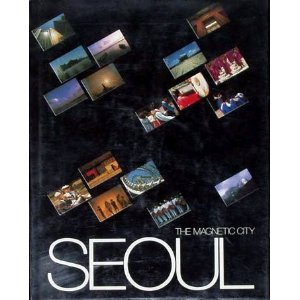 “Taller and more ruggedly built than their counterparts in Tokyo, Manila, or Bangkok, the people of Seoul exude a sense of resiliency and vitality,” writes Peter Hyun in this book’s introduction, “so much so that they make the other Asians look downright indolent.” Ah, perhaps we have here a publication of the Korean History Channel. “Seoul’s women, with their well-scrubbed, rosy-cheeked faces, look strikingly healthy and beautiful.” Read books from Korea on Korea printed in a certain era, and you’re never far from propaganda, but the country’s peculiar flavor of nationalism merits study. “The Koreans are a people with a strong sense of historically justified fear that their own fate has rarely been in their own hands,” Hyun writes toward the end. “This sober fact explains much of their drive to build economic and social stability as well as to preserve their own cultural identity.” A few pages on, he finds room for a parting shot: “Furthermore, the Koreans are the only people in the world who make even the Japanese — often accused by Westerners of being maniacally devoted to their work — look lazy.”
“Taller and more ruggedly built than their counterparts in Tokyo, Manila, or Bangkok, the people of Seoul exude a sense of resiliency and vitality,” writes Peter Hyun in this book’s introduction, “so much so that they make the other Asians look downright indolent.” Ah, perhaps we have here a publication of the Korean History Channel. “Seoul’s women, with their well-scrubbed, rosy-cheeked faces, look strikingly healthy and beautiful.” Read books from Korea on Korea printed in a certain era, and you’re never far from propaganda, but the country’s peculiar flavor of nationalism merits study. “The Koreans are a people with a strong sense of historically justified fear that their own fate has rarely been in their own hands,” Hyun writes toward the end. “This sober fact explains much of their drive to build economic and social stability as well as to preserve their own cultural identity.” A few pages on, he finds room for a parting shot: “Furthermore, the Koreans are the only people in the world who make even the Japanese — often accused by Westerners of being maniacally devoted to their work — look lazy.”
In between Hyun’s words come pages and pages of pictures, making Seoul: The Magnetic City essentially a photo book sandwiched between a few very short essays. The images cover the usual stuff: weddings, festivals, street scenes, colorful traditional dances, kids running around, old people shopping in complicated-looking grain markets, rush-hour traffic, historical landmarks, hulking new towers sometimes still under construction. While traveling, I, like many others, tend to turn my head for new things amid old or old things amid new. The long-standing (for varying definitions of “standing”) but rapidly and recently developed Seoul, with its gates and temples surrounded by sweeping infrastructure and futuristic high-rises, seems to provide just these sort of contrasts in great abundance. On a side-trip to Seoul during a stretch in Taipei, my friend Nick filled an entire blog post with pictures of the traditional and the modern coexisting there.
Written — or shot, if you like — in 1984, the book examines a Seoul clearly on a bewilderingly fast rise but still not quite as far open as it would crack after the 1988 Summer Olympics. East Asia of the eighties fascinates me; I’ll read any book or watch any film from that slice of the space-time continuum. (Most of the language-learning videos I use date from that era, too, and I watch them every day.) Don’t let the Korean History Channel hear, but eighties Japan fascinates me most of all. Presented with the opportunity to simply drop myself into a time and place, I feel I’d have no choice but Tokyo from about 1960 through 1990. Until that technology comes along, though, good old photo books still offer the next best experience. Using Seoul: The Magnetic City’s sometimes strangely dim and indistinct but large and often striking pictures for that purpose, I found myself surprised by the look of the townswomen. Well-scrubbed and apple-cheeked though they may have been, they dressed so… frumpy. The ladies of the Japanese eighties must have inflated my expectations for aesthetic boldness.
Then again, Korea had to more or less rebuild itself from the early fifties, after the Korean War; Japan had more to work with after the Second World War. In any other country facing the kind of historical setbacks Korea has, you’d expect the women to look dowdy even today. In 1984, their style, usually a reliable reflection of development, seems to have been a lagging indicator. The dullness of their dress, then — if you’ll allow me to emulate the voice of this book’s most boosterist passages — stands as a testament to the South Korean “Miracle on the Han River,” an industrialization, technical specialization, and lifestyle modernization so forceful that it left even a sector as aggressively au courant as women’s fashion panting to catch its breath. All reports from the streets of Seoul today, however, assure me the issue has been corrected — possibly too corrected. You can cool it on the plastic surgery, ladies. That eyelid one freaks us out.
Post a Comment